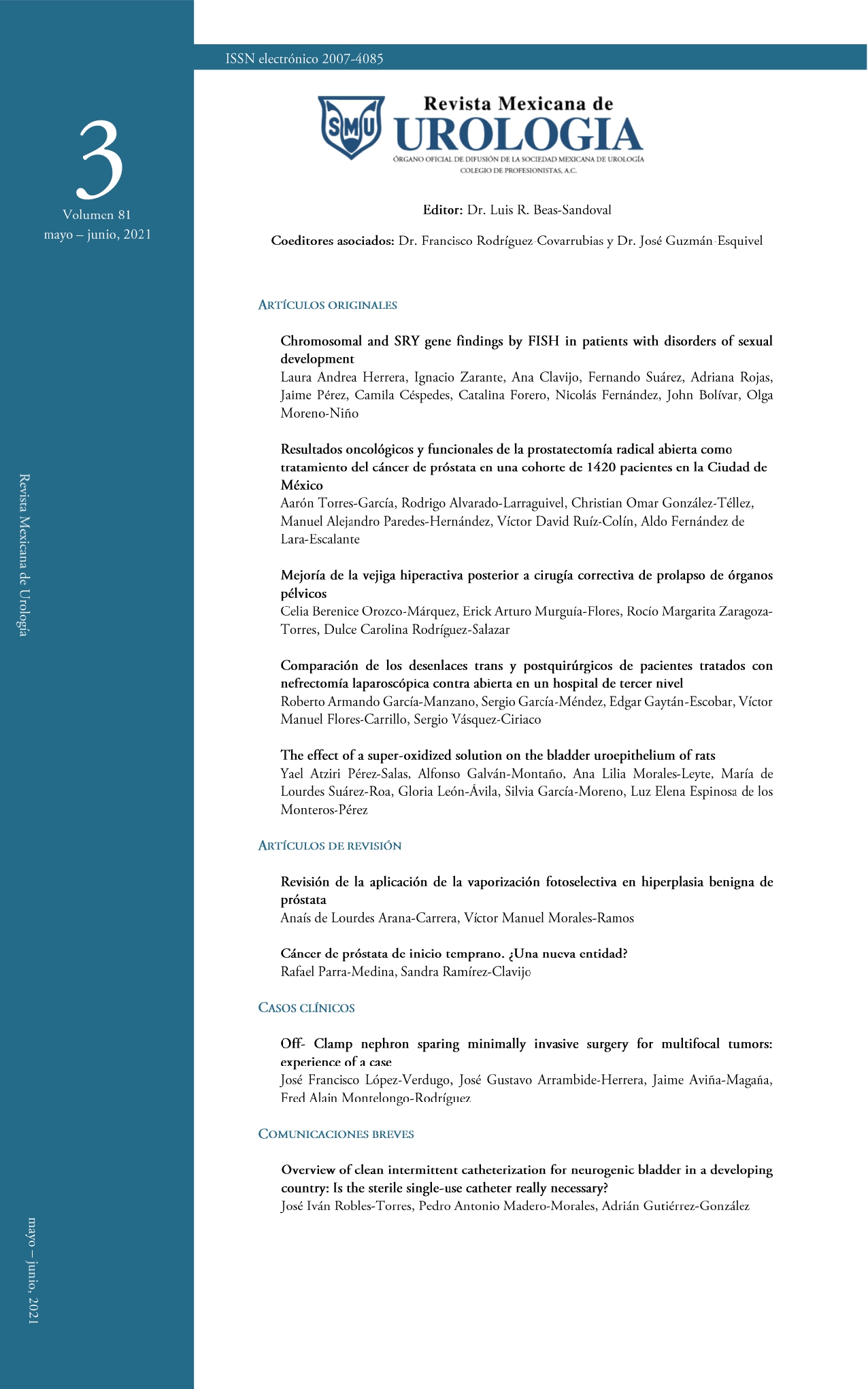The effect of a super-oxidized solution on the bladder uroepithelium of rats
DOI:
https://doi.org/10.48193/revistamexicanadeurologa.v81i3.775Keywords:
Superoxide, disinfectant, urinary bladder, rat, 16S rRNA, UTIsAbstract
Aim: The present study aimed to identify the changes on the bladder mucosa in rats after intravesical infusion of Super-oxidized solution (SOS) (Mycrodacyn60® Mexico).
Design: Eighteen Wistar Albino rats weighing 250-300 g were randomly categorized into three groups. Rats in Group 1 were infused with a single dose of 1.5 ml of 0.9% saline solution (SS) whereas those in group 2 were administered a single dose of 1.5 ml pH neutral SOS. Control rats in Group 3 did not undergo any procedure.
Results: The absence of bacteria was verified before and after the administration of the solution, performing urine cultures and amplifying the 16S rRNA fragment by PCR and histopathological examinations for each bladder. The absence of bacterial DNA in the uroepithelium was demonstrated, histopathological examination revealed, that irrigation with SOS, in histological observation, no structural alterations were identified in the urothelial mucosa.
Limitations: It was not possible to analyze the effect of SOS absorption indamage to the uroepithelium secondary to traumatic infection or injury. The effect of irrigation at different times and volumes with SOS was also not analyzed.
Originality: It is known that SOS is useful as disinfectant in skin and serosa bacterial infections, lacking toxicity and it is effective against Escherichia coli. The use of superoxide solutions in cavities such as the bladder, has not been investigated yet.
Conclusion: The pH-neutral SOS infused transurethral in the bladder of rats has no adverse effects on the uroepithelium, which was supported by histopathological evidence.
References
Hadi SF, Khaliq T, Bilal N, Sikandar I, Saaiq M, Zubair M, et al. Treating infected diabetic wounds with superoxidized water as anti-septic agent : a preliminary experience. J Coll Physicians Surg Pak. 2007;17(12):740–3. doi: 12.2007/JCPSP.740743
You HS, Fadriquela A, Sajo MEJ, Bajgai J, Ara J, Kim CS, et al. Wound Healing Effect of Slightly Acidic Electrolyzed Water on Cutaneous Wounds in Hairless Mice via Immune-Redox Modulation. Biol Pharm Bull. 2017;40(9):1423–31. doi: 10.1248/bpb.b17-00219
Landa-Solis C, González-Espinosa D, Guzmán-Soriano B, Snyder M, Reyes-Terán G, Torres K, et al. Microcyn: a novel super-oxidized water with neutral pH and disinfectant activity. J Hosp Infect. 2005;61(4):291–9. doi: 10.1016/j.jhin.2005.04.021
Kraft A. Electrochemical Water Disinfection: A Short Review. Platinum Metals Review. 2008 Jul 31;52(3):177–85. doi: 10.1595/147106708X329273
Kubota A, Goda T, Tsuru T, Yonekura T, Yagi M, Kawahara H, et al. Efficacy and safety of strong acid electrolyzed water for peritoneal lavage to prevent surgical site infection in patients with perforated appendicitis. Surg Today. 2015;45(7):876–9. doi: 10.1007/s00595-014-1050-x
Aras A, Karaman E, Çim N, Yıldırım S, Kızıltan R, Yılmaz Ö. The effect of super-oxidized water on the tissues of uterus and ovary: An experimental rat study. Eastern J Med. 2017;22(1):15–9. doi: 10.5505/ejm.2017.42714
Rossi-fedele G, de Figueiredo JAP, Steier L, Canullo L, Steier G, Roberts AP. Evaluation of the antimicrobial effect of super-oxidized water (Sterilox®) and sodium hypochlorite against Enterococcus faecalis in a bovine root canal model. J Appl Oral Sci. 2010;18(5):498–502. doi: 10.1590/S1678-77572010000500012
Zinkevich V, Beech IB, Tapper R, Bogdarina I. The effect of super-oxidized water on Escherichia coli. Journal of Hospital Infection. 2000;46(2):153–6. doi: 10.1053/jhin.2000.0819
National Advisory Committee for Laboratory Animal Research. Guidelines on the Care and Use of Animals for Scientific Purposes. Singapore; 2004.
Diario Oficial Mexicano. Especificaciones técnicas para la producción, cuidado y uso de los animales de laboratorio. NOM-062-ZOO-1999. 2001.
Rojo A. Cálculo del tamaño muestral en procedimientos de experimentación con animales. Valoración de las incidencias. Animales de Laboratorio. Revista de la Sociedad Española de las Ciencias del Animal de Laboratorio. 2014;62:31–33.
Diario Oficial Mexicano. Protección ambiental - Salud ambiental - Residuos peligrosos biológico-infecciosos - Clasificación y especificaciones de manejo. NOM-087-ECOL-SSA1-2002 2005.
Barron E, Thompson R. Specimen collection transport, and processing: Bacteriology. In: Manual of Clinical Microbiology. Washington, D.C: Ed. Murray PR; 2003. p. 320–1.
Murray MG, Thompson WF. Rapid isolation of high molecular weight plant DNA. Nucleic Acids Res. 1980;8(19):4321–5. doi: 10.1093/nar/8.19.4321
Fierer N, Jackson JA, Vilgalys R, Jackson RB. Assessment of soil microbial community structure by use of taxon-specific quantitative PCR assays. Appl Environ Microbiol. 2005;71(7):4117–20. doi: 10.1128/AEM.71.7.4117-4120.2005
Rolls G. Scientia Education Series: Microtomy and Paraffin Section Preparation. 2010.
Singal R, Dhar S, Zaman M, Singh B, Singh V, Sethi S. Comparative Evaluation of Intra-Operative Peritoneal Lavage with Super Oxidized Solution and Normal Saline in Peritonitis Cases; Randomized Controlled Trial. Maedica (Bucur). 2016;11(4):277–85.
Altamirano AM. Reducing Bacterial Infectious Complications from Burn Wounds A look at the use of Oculus Microcyn60 to treat wounds in Mexico. Wounds. 2006; Suppl January:17–9.
Ni L, Zheng W, Zhang Q, Cao W, Li B. Application of slightly acidic electrolyzed water for decontamination of stainless-steel surfaces in animal transport vehicles. Prev Vet Med. 2016; 133:42–51. doi: 10.1016/j.prevetmed.2016.09.010
Game FL, Apelqvist J, Attinger C, Hartemann A, Hinchliffe RJ, Löndahl M, et al. Effectiveness of interventions to enhance healing of chronic ulcers of the foot in diabetes: a systematic review. Diabetes Metab Res Rev. 2016;32 Suppl 1:154–68. doi: 10.1002/dmrr.2707
Aras A, Karaman E, Yıldırım S, Yılmaz Ö, Kızıltan R, Karaman K. Intraperitoneal Infusion of Neutral-pH Superoxidized Solution in Rats: Evaluation of Toxicity and Complications on Peritoneal Surface and Liver. Med Sci Monit. 2017;23:960–5. doi: 10.12659/msm.899453
Waites KB, Chen Y, DeVivo MJ, Canupp KC, Moser SA. Antimicrobial resistance in gram-negative bacteria isolated from the urinary tract in community-residing persons with spinal cord injury. Arch Phys Med Rehabil. 2000;81(6):764–9. doi: 10.1016/s0003-9993(00)90108-4
Waites KB, Canupp KC, Roper JF, Camp SM, Chen Y. Evaluation of 3 methods of bladder irrigation to treat bacteriuria in persons with neurogenic bladder. J Spinal Cord Med. 2006;29(3):217–26. doi: 10.1080/10790268.2006.11753877






